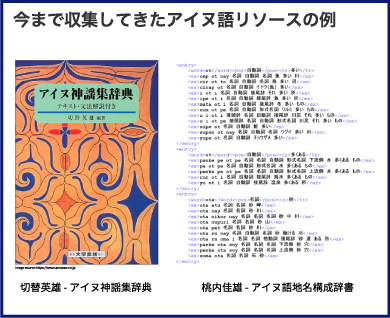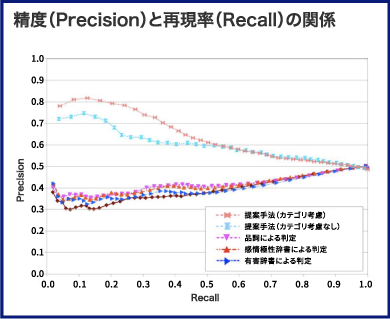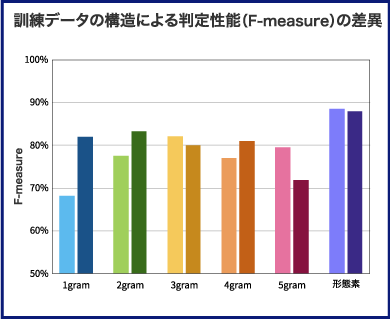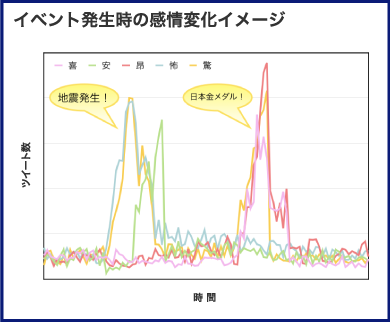NATURAL LANGUAGE PROCESSING
We have been conducting research focusing on the “language” that people use everyday.
AINU LANGUAGE

![]() Research Background and Issues
Research Background and Issues
It is believed that about 90% of the world’s languages, including the Ainu language, are in danger of extinction. The Ainu language, the language of the Ainu people living in Okhotsk
There are no written forms. All records of the language are oral and written, passed down from generation to generation, a fact that makes it difficult to preserve the language.
![]() Research Objective
Research Objective
The aim of this project is to support the maintenance and recovery of crisis languages such as Ainu.
![]() Initiatives to Solve Issues
Initiatives to Solve Issues
Development of technology for Ainu language learning and research development
- Collection and digitization of Ainu language materials
- Development of optimal language processing technology for the Ainu language
- Public disclosure of developed technologies

![]() Achievements to Date
Achievements to Date
Our aim is to realize “machine translation” from “dictionary construction” in natural language processing. At present, more than 1,750,000 Ainu texts and their Japanese counterparts are collected as digital data and used for the development of natural language processing techniques for Ainu language processing. This has led to the successful development of Ainu notation + word segmentation, grammatical analysis (part-of-speech tagging) and word-level automatic translation.

![]() Future Perspective
Future Perspective
- Construction and maintenance of a natural language processing environment for the Ainu language.
- Collection and analysis of Ainu texts
- Construction of a digitalized corpus of the Ainu language including word and part-of-speech information
- Development of technology for analyzing Ainu texts

HARMFUL INFORMATION DETECTION

![]() Research Background and Issues
Research Background and Issues
With the spread of the Internet, “cyber bullying” has become a social problem. Harmful words posted on the Internet can be signs of damage caused by cyberbullying or threats of damage that could become serious in a short period of time, such as criminal threats.
![]() Research Objective
Research Objective
This project aims to develop assistive technologies for net patrol activities.
![]() Initiatives to Solve Issues
Initiatives to Solve Issues
Development of technology for automatic detection of harmful posts
- Reduce the burden of Internet patrol activities
- Quantification of harmfulness of online postings
- Detection of posts that exceed a certain level of harmfulness

![]() Achievements to Date
Achievements to Date
Our goal is to discover sentences that contain harmful words with high accuracy by applying natural language processing and deep learning techniques. Currently, we have proposed a category-based relevance maximization method that determines the harmfulness of words contained in sentences by considering three categories of words: defamatory words, words that provoke violence, and obscene words, and have successfully determined harmful posts using deep learning with approximately 88% accuracy.

![]() Future Perspective
Future Perspective
- Development of automatic judgment method
- Application to the real world and verification of effectiveness

COMPUTATIONAL MODEL OF METAPHOR

![]() Research Background and Issues
Research Background and Issues
In different countries, even synonymous words may have different interpretations due to cultural and historical differences. Therefore, we focus on the fact that the image of a target word (query) can be expressed in a broad sense by tracing the metaphorical relationship between words, and by conducting this in multiple languages on the Internet, we compare the semantic interpretation of queries and analyze the differences.
![]() Research Objective
Research Objective
This project aims to eliminate interpretation discrepancies due to language differences.
![]() Initiatives to Solve Issues
Initiatives to Solve Issues
Application of Metaphorical Drawing Techniques in English
- Determination of Metaphor Index
- Determination of search engines to be used as corpora
- Grammar-aware collection of knowledge fragments
- Comparison with multilingual methods

![]() Achievements to Date
Achievements to Date
We have successfully built a knowledge acquisition system (Murasaki) using a computational model of metaphor, implemented Murasaki in multiple languages (Japanese, Vietnamese, Korean, Chinese, and English), and conducted a comparative analysis of “word images” in multiple languages. We have also conducted extraction experiments using English figurative indexes, re-extracting correct figurative expressions among the extracted expressions, and investigating expressions that should be excluded, such as personal names and pronouns.
![]() Future Perspective
Future Perspective
- Development of a model to quantify figurativeness of language
- Development of figurative drawing methods
- Development of web applications based on figurative drawing
- Multilingualization of figurative drawing techniques
- Analyze figurative expressions using figurative drawing techniques.

EMOTIONAL INFORMATION PROCESSING

![]() Research Background and Issues
Research Background and Issues
With the spread of smartphones, the dissemination of text information has become familiar. Under such circumstances, there is a growing interest in the automatic analysis of user behavior and intentions. We are developing unprecedented open software for sentiment analysis, aiming for a technology that can appropriately recognize user sentiment in real time from text information.
![]() Research Objective
Research Objective
This project aims to eliminate interpretation discrepancies and differences by automatically analyzing user behavior and intentions.


![]() Initiatives to Solve Issues
Initiatives to Solve Issues
Development of Emotional Information Open Software
- Analyze input text
- Evaluate the emotional meaning of each word
- Assign appropriate emotional information
![]() Achievements to Date
Achievements to Date
The emotion analysis system ML-Ask originated in this laboratory. This research has provided a baseline for similar studies and is being used as an experimental tool. This laboratory has also applied this to research on sentiment analysis during posting on Twitter, and has developed a basic Tweet acquisition program.

![]() Future Perspective
Future Perspective
- Application to corpus creation with emotional information
- Improvement and expansion of in-system dictionaries

